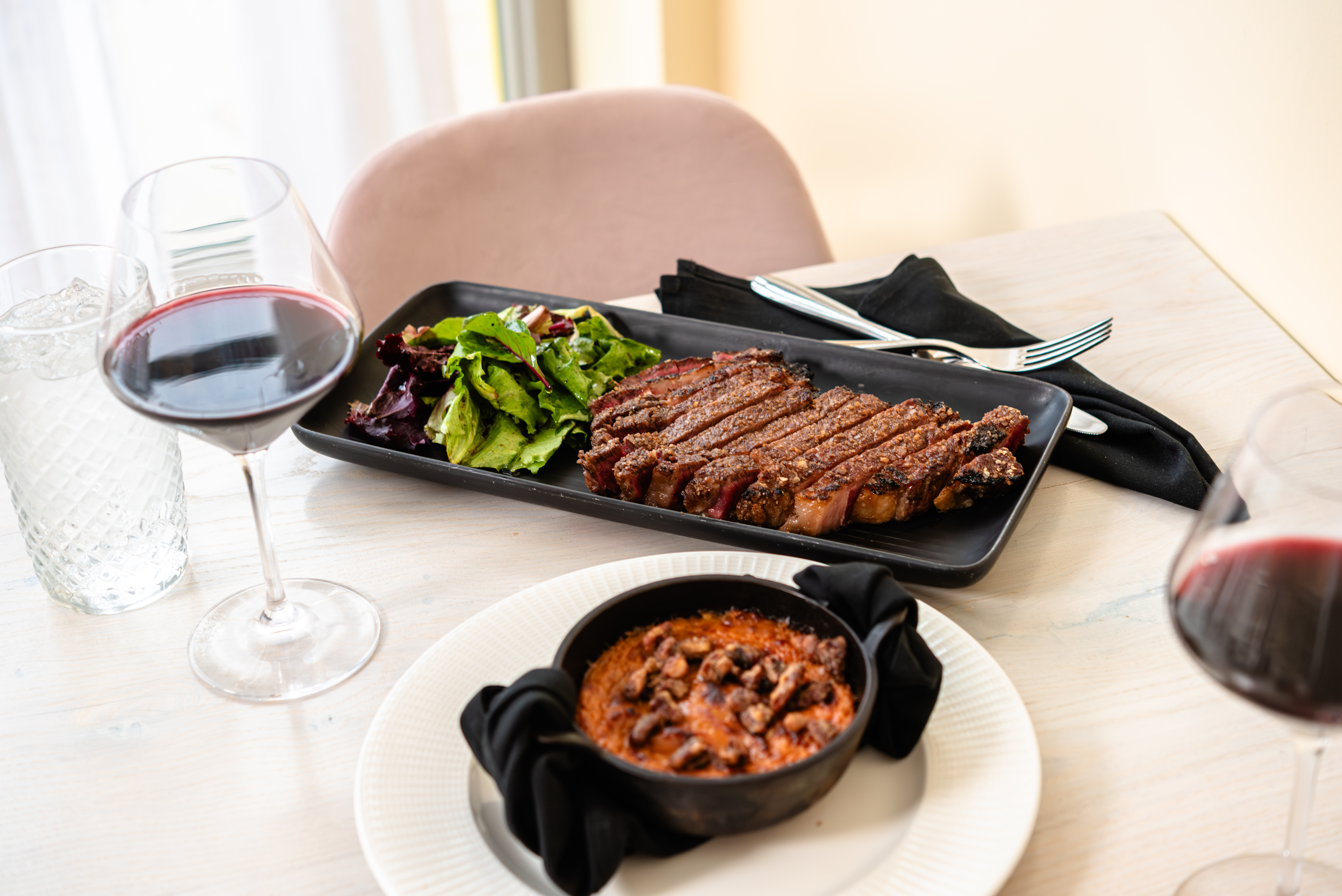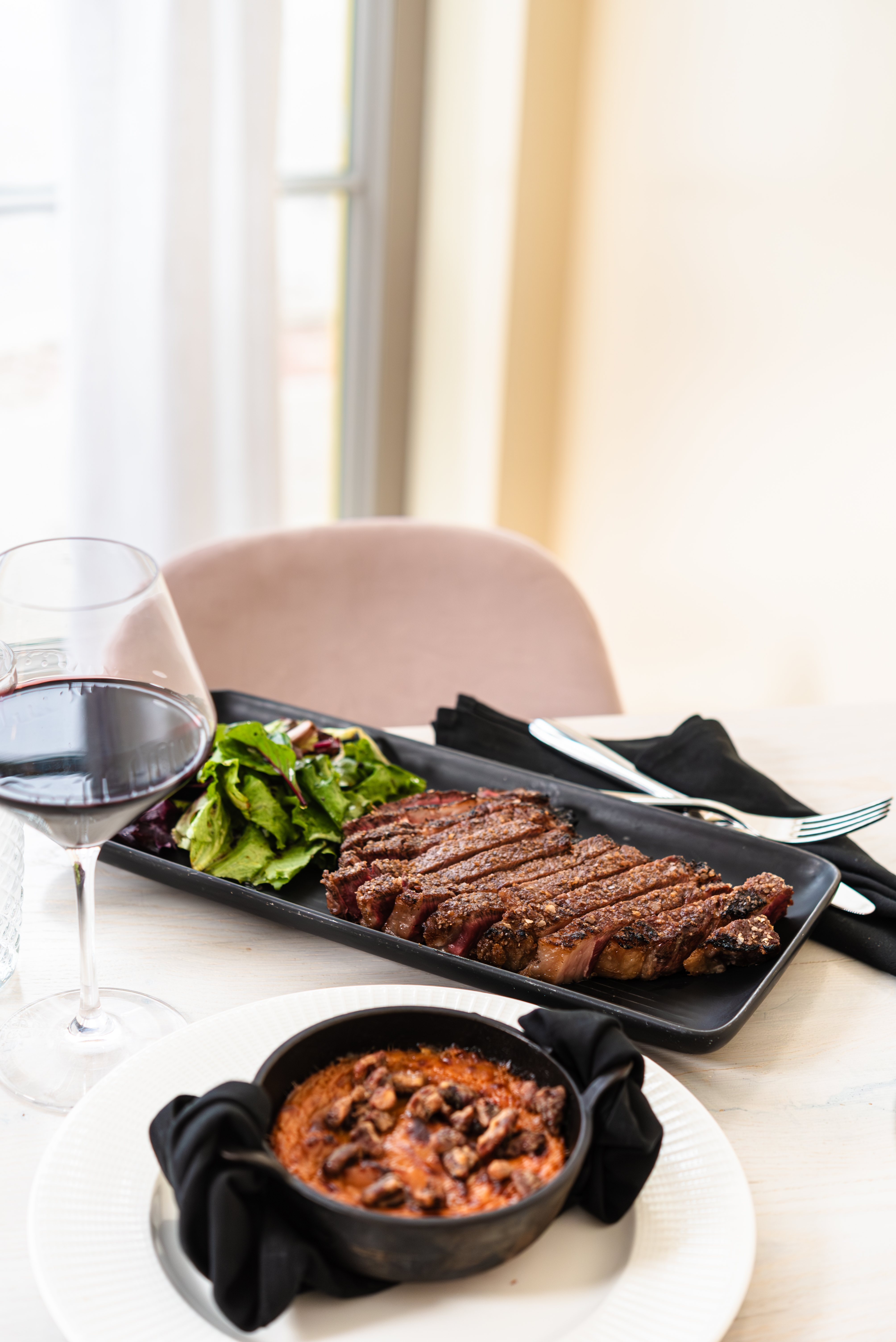Raising the Barn
by Laura Adiletta | Nov. 18, 2014 | 5:00 AM
Walking into Urban Farmer is a little like walking into your grandmother's living room — if your grandmother was super cool and lived in a barn.
In the lounge, mismatched and eclectic furniture tucks underneath funky framed portraits and paintings of cats that cover nearly every inch of the reclaimed barn wood walls. The dining room's patchworked upholstery pairs with comfortable dining tables that stand in for impersonal rows of two-tops.
Off the main room you'll find a party area papered in a bold, vintage print set off by stunning ostrich feather chandeliers. There's even an open pantry lined with jars of colorful carrots, beans and cauliflower. It's enough to make you feel like moving in.
But it's what's behind those walls that makes Urban Farmer, located in the new Westin Cleveland Downtown hotel, most inviting.
On this October day, white jackets hustle back and forth across the large, open kitchen. A 6-foot baker's rack loaded with a variety of tomatoes — the last of the season — stands within arm's reach. Nearby, two chefs prepare to can 600 pounds of Concord grape jelly. Last week, they preserved 150 pounds of pear butter and 400 pounds of hot sauce.
"They're canning right now because it's fall, and we're coming to the end of growing season," says Troy Christian, general manager of food and beverage. "They're stocking up so we have a lot of stuff for the winter."
Past the dry storage area, through a narrow corridor and down a freight elevator, aproned workers line up room service carts for Westin guests. Around the corner in the restaurant's bakery, a pastry chef stands over a butcher block counter, scooping flour from a bin. Here there are more racks, though she has loaded these with English muffins, rolls and cornbread baked in aluminum cans. Others are baking, visible through the doors of the double oven behind her.
Behind a heavy steel door, three men stand in a refrigerated room busily breaking down a huge side of beef into individual steaks. They start with a whole cow, about one every month.
"They weigh anywhere from 800 to 1,000 pounds," says sous chef Ben Lerner. "From there, we break it down into primal cuts. All the steak cuts — the tenderloin, the strip — will go onto the specials card. Then we'll have to find utilization for the rest of the animal."
The steaks are run as daily specials and stamped "sold out" when they're gone. "Sometimes people [are] like, It's Saturday night at 7 o'clock and you're already out?' " says Christian. "It's like, Well, we bought the whole cow, we didn't buy a whole bunch of New York steaks."
Rather than waste the leftovers, the chefs think up myriad alternatives: ground beef for burgers, roast beef, bone marrow and beef stock. Even the candles on the table are made in-house from purified tallow.
All part of Urban Farmer's core philosophy, its commitment to local sources is obviously taken very seriously. Foodies will recognize featured farms, such as Miller Livestock Co., Green City Growers and Mackenzie Creamery throughout their entire meal. It's surprising how much of the menu is grown or raised within 100 miles, since the Cleveland steakhouse, which opened May 15, is actually the second of its kind. The original is more than 2,000 miles away in Portland, Oregon. Matt Christianson, director of culinary operations for Sage Restaurant Group, worked for more than a year to develop relationships with local vendors.
"We try to have the food inspired by seasons, so people can really feel the purity of what they're experiencing," he says. So it's not a gimmick that will disappear as the weather grows colder: Local food is what Urban Farmer is, not just what it does.
Overall, the dining experience at Urban Farmer is impressive, even with some technical failings. The cocktail list is grouped by flavor profile (sweet, herbal, bubbly). I chose a daiquiri made with pawpaw ($10), an Ohio-native fruit that tastes like a mixture of mango and banana. It was unique and expertly mixed, delivered in a classic cocktail glass.
The appetizers, including steak tartare with fennel ($16) and cornmeal-crusted shrimp with green tomato jam ($15), were massive, more tapas than starters. Still, the tartare tasted extremely fresh, with buttery toast points and a bitter salad that helped to cut its richness. Aside from its size, it's perfect for skeptical diners who haven't yet worked up the nerve to try this adventurous classic.
Side dishes are textural and large enough to share: roasted Killbuck Valley mushrooms with crispy shallots ($11); crunchy, savory pole beans and sofrito ($12); an addictive fingerling potato and bacon tart ($11).
I expected the entrees to be better, given the price and skill with which these proteins are fabricated. The special-menu venison and root vegetable puree ($42) and a grass-fed rib-eye ($47) were both tough and undercooked. However, a melt-in-your-mouth candied bacon add-on to the steak was worth the extra $9, and a couple of artfully composed desserts — chocolate pave with olive oil ice cream ($10) and apple doughnuts with flowering thyme ice cream ($10) — closed the meal on a sweet note.
I might order something different next time, but there will definitely be a next time. Knowing that my food was raised with care, carved by hand and utilized as completely as possible makes an error or two forgivable.
"When we talk about restaurants doing nose-to-tail or that they're doing whole pigs, things like that, that's very much what Urban Farmer is doing," says Christianson. "There's nothing that comes into Urban Farmer prefabricated."
Urban Homesteading
Want to start a collection of preserved ingredients for your own Urban Farmer-inspired pantry? But we aren't a fan of the years-old basic mix that has been gathering dust on the spice rack. So Urban Farmer's director of culinary operations, Matt Christianson, taught us how to make a unique brine that will complement rather than mask the flavor of the vegetables you want to preserve. "It is best used with ramps that will pop out of the ground in abundance in Ohio come spring," he says. If you just can't wait to try it out he recommends using chanterelle mushrooms. Pickled chanterelles are firm and earthy and are great tossed on salads, omelets, burgers or pizza. As a bonus, Christianson says, "After the pickled vegetables are used up, keep the left over pickling liquid [to] add to sauces and salads for a little extra flavor."
Pickled Chanterelles recipe
Servings: 1 quart
1 quart Champagne vinegar
4 cups sugar
¼ cup fennel seed
¼ cup dill seed
¼ cup fenugreek seed
¼ cup coriander seed
8 Thai bird chili (these are spicy; reduce if you're sensitive to heat)
8 cloves
4 cinnamon sticks
5 fresh bay leaves
Brush any loose soil from the chanterelles. Tear large mushrooms so that all of the chanterelles are approximately the same size. On medium-high heat, dry saute the mushrooms, shaking frequently, until they begin to release some of their liquid. Remove from heat. Measure out all the spices and tie them into a sachet using cheesecloth (or a large coffee filter). Bring the sugar and vinegar to a boil, then add the sachet and return to a boil. Remove from heat and allow the spice flavors to infuse for at least 30 minutes. Pour the pickling liquid over the chanterelles, including the sachet (ensure it's all submerged). Store in the refrigerator. For shelf-stable cans, ladle ingredients into sterile jars and seal tightly, then set jars on a rack inside a large pot. Cover completely with boiling water and boil for 15 minutes. Cool. Remove, wipe dry and store.
TRY THIS: Steak and potatoes are a classic combination for a reason, but you don't have to settle for a simple side of mashed (though that's on the menu, too). Instead, order the twice-baked fingerling potato tart with aged cheddar, bacon and chives ($11). GOOD TO KNOW: Urban Farmer ups the brunch ante with an in-house bakery that pumps out fresh English muffins the size of your face. Go traditional with a locally raised New Creations Farm ham Benedict ($13) or embrace the steakhouse vibe with the grass-fed sirloin version ($14).
Trending
-
1
-
2
-
3
-
4
-
5










